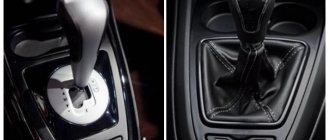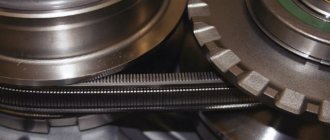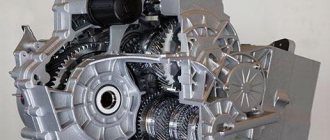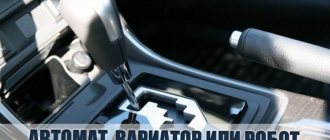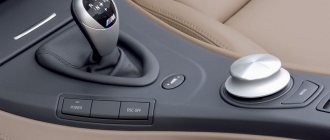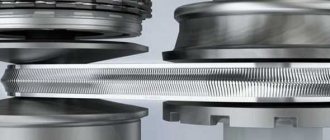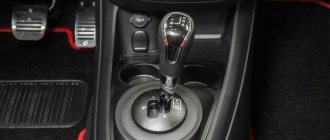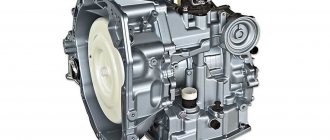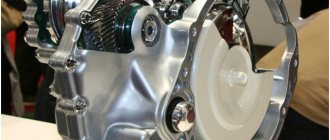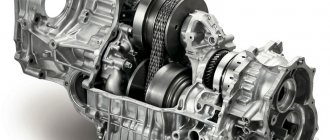Every self-respecting driver should understand the principle of operation of a car's gearbox. The gearbox is considered one of the most important components of a vehicle's transmission. Its main task is to change the speed of torque and transmit it from the engine shaft to the wheels, interrupting the connection between the power unit and the entire transmission. There are several types of gearboxes that determine the type of vehicle transmission.
What is a gearbox, role, meaning, operating principle
After the clutch, the main component of the vehicle is the gearbox.
In most cars, it is equipped with gears, and the number of gears varies from 4 to 6, excluding reverse gear. The process of gear shifting occurs due to the clutch of gears among themselves in a certain order, possibly with the help of synchronizers or by blocking the shaft gears. Synchronizers serve to equalize the rotation speed and fix the work of one of the driven shafts. The primary function of the gearbox is to achieve optimal torque between the engine and the wheels. Its main components are:
- Carter. Includes in its design all the main parts and components of the gearbox. Mounted on the clutch housing, which is in contact with the vehicle engine. The crankcase cavity is 50% filled with transmission, or in rare cases, engine oil. Since all gears are subject to high stress and friction, a large amount of lubricant helps relieve stress on the parts and prevent them from quickly wearing out.
- Synchronizers AVTOKPP.KZ. Designed for smooth connection of gears, shockless gear shifting by equalizing the angular speeds of gear movement.
- Switching mechanism. It has a lever in the car's interior, which directly serves as a control for starting the operation of the entire system. Has locking and locking mechanisms. The first does not allow two gears to be switched on at the same time, and the second, in turn, prevents the gear from being switched off arbitrarily.
- Shafts. Primary or leading, secondary or driven and intermediate. Perform rotation in the crankcase bearings; have different numbers of gears. Depending on the type of gearbox, there may be a different number of shafts, which require different designs for transmitting torque.
Method of interaction and number of shafts
In modern gearboxes, two main methods of interaction between shafts are used - mechanical and hydraulic. Mechanical is used for CVT, manual transmission and AMT, hydraulic is intended for automatic transmission, as well as CVT.
Mechanical, in turn, is implemented by using:
- gear transmission, in the predominant number of cases based on bevel or cylindrical gears;
- planetary gear, includes such elements as a sun gear (it is simply called the sun), an epicycle (a large wheel called a crown), a lever mechanism (called a carrier, also known as a space fork) and gear wheels (also known as satellites);
- friction transmission, practically cannot be installed independently, only with planetary gears or gears.
The hydraulic type of shaft interaction in its pure form is very, very rare. In the majority of cases, we are talking about a hydromechanical scheme based on the installation of a fluid coupling or torque converter, as well as a planetary mechanical transmission.
The next important classification parameter is the number of shafts. The three most common schemes are:
- two-shaft;
- three-shaft;
- multi-shaft
And to complete the picture, the fourth is a shaftless manual transmission, a very rarely used solution.
The two-shaft scheme is based on the installation of two shafts, one primary (driver), the second secondary (driven). Classics of the genre.
The three-shaft scheme is more complicated. There are three shafts; in addition to the two mentioned above, there is also an intermediate one. In addition, such a scheme can be coaxial or non-coaxial (involves the installation of a transfer case).
The multi-shaft scheme corresponds to the two-shaft scheme, only there are several driven, and sometimes driving, shafts.
Classification of gearbox types
Experienced motorists are accustomed to classifying gearboxes according to several criteria. These include:
- Power outflow transmission option (manual gearboxes, planetary, with coaxial shafts, variator, hydromechanical);
- Number of shafts (two-shaft, three-shaft, multi-shaft with different numbers of gears);
- By control method (automatic, robotic, manual activation).
The most common classification divides gearboxes according to their operating principle:
- Manual gearboxes. They are famous for their high efficiency with minimal weight. It is believed that a manual transmission provides better dynamic acceleration of the vehicle with relatively economical fuel consumption.
- Automatic. They are easy to use. However, it is noted that in many cases the car’s fuel consumption increases and shifts gears slowly.
- Robotic gearboxes. They are a symbiosis of mechanics and automatic. In simple terms, a robotic gearbox is very similar to a manual gearbox, but with electronic control of the clutch. Reviews say that this option is significantly inferior to an automatic transmission.
- CVTs or continuously variable transmissions. A relatively new type of gearbox, characterized by the direct absence of gears. The gear ratio in the variator changes smoothly, without dynamic steps. Today, CVTs are only becoming widespread, since the design features of continuously variable transmissions are not perfect. In many cases, the transmission belt is not able to withstand the power of modern car engines, which quickly disables the system.
Variable speed drive
The CVT is a continuously variable gearbox. This transmission is quite simple. The torque varies smoothly, ensuring an absolutely smooth ride. The efficiency of such a box is quite high, since there are no additional mechanisms and gears.
The variator consists of two pulleys that can change their size and are connected by a special belt, which allows you to select the best ratio of gear ratios.
The disadvantage of the variator is its limited applicability due to the inability to use it on sufficiently powerful engines. So the main area of application for such a gear shift system is urban small cars and scooters.
Characteristics of a manual transmission
The manual transmission device provides for manual control of gear shifting by moving the lever. There is a stepwise transmission of torque. A manual transmission requires a gear ratio. The indicator for a pair is determined by the proportion of the number of teeth of the active transmission elements.
Mechanical boxes are divided by the number of stages. The most common is the five-speed manual transmission.
Separately, the mechanics are divided by the number of internal shafts: two-shaft and three-shaft manual transmissions. The former is more intended for passenger front-wheel drive vehicles, while the latter is more often used for large heavy vehicles and can be applied to cars with any type of drive.
Disadvantages of manual transmission
Like any car component, a manual transmission is not without its drawbacks:
- Complex control, involving simultaneous manipulation of the clutch pedal and shift lever.
- The need to control the operating mode of the motor. Only in this case is it possible to ensure dynamic acceleration and certified fuel consumption indicators.
- If handled carelessly, there is a risk of breaking the clutch or gearbox gears.
- There is a risk of “over-twisting” the engine crankshaft by engaging the wrong gear.
- Disruptions in power flow during switching moments.
- Tiring control of the gearbox when driving in traffic jams. The driver constantly has to change gears.
- Step change in gear ratio and limited number of speeds. Because of this, it is not always possible to find the optimal engine operating mode. Modern cars use electronic systems that prompt the driver when to change speed.
The disadvantages of manual transmissions are only noticeable to novice or inexperienced drivers.
Features of two-shaft and three-shaft manual transmissions
In the case of a three-shaft manual transmission, the clutch disc helps transmit torque to the input shaft. After this, rotation passes to the intermediate shaft, which launches the elements of the driven shaft.
After a certain gear has been engaged, the required fork is selected and the longitudinal movement of the lever begins. The fork moves relative to the shaft and triggers the synchronizer. The ring gear operates after the synchronizer equalizes the angular velocity. The crown connects the driven shaft and the required gear, and the rotational moment is directed to the gearbox shank and through the cardan to the rear axle.
Typically, three-shaft gearboxes use direct transmission - thanks to synchronizers, the two shafts are directly connected. In this case, the gear ratio is 1. If you use different numbers of teeth on the gears, then the gear ratio can be varied. However, the transmission system will lose its meaning when the engine speed becomes equal to the shaft speed. Manual transmissions use helical gears. Thanks to this design, it is possible to achieve smooth engagement of the required gear.
Manual transmissions use helical gears. Thanks to this design, it is possible to achieve smooth engagement of the required gear.
Principle of operation
A mechanical transmission is required to change the torque and transmit it from the internal combustion engine to the wheels. The torque coming from the engine is supplied to the input shaft of the box using the clutch pedal. Due to this, it is transformed by interconnected pairs of gears (steps) and transmitted directly to the wheels of the car.
All gear pairs have their own gear ratio, which is responsible for the number of revolutions and the supply of torque from the engine crankshaft to the wheels. An increase in torque by the transmission causes a decrease in crankshaft speed. When it decreases, it’s the other way around. Before changing gears in a manual transmission, you need to depress the clutch pedal, which interrupts the flow of power from the internal combustion engine. The vehicle always starts moving from gear 1 (except for trucks), and the subsequent increase in gear occurs gradually, with a sequential change of gearbox stages from low to high. The moment of switching is determined by the speed of the car and the indicators of the instruments: tachometer and speedometer.
Robotic gearbox
The operating principle of a robotic gearbox is similar to a mechanical one, but with a slight improvement in the form of actuators for shifting gears. The similarity with an automatic transmission is manifested only in the fact that the clutch is located in the box body (on the manual transmission it is located on the flywheel).
In a robotic gearbox, one drive shaft has an internal cavity through which the second shaft is attached. Both shafts have a separate clutch and a certain set of interacting ones, if necessary. The clutch and synchronizers are controlled through the operation of servos. Servos or actuators come in several types: electric or hydraulic.
The entire operating mechanism and interaction with other vehicle systems is controlled by a microprocessor control unit (MCU). Engine sensors are connected to it, and the MCU itself is connected to the on-board computer.
A second clutch in a manual transmission is necessary to reduce the time between gear changes.
How a beginner can learn to operate mechanics
When learning to drive a car with a manual transmission, you need to train certain skills and abilities. First of all, this concerns the ability to smoothly release the clutch pedal while simultaneously adding gas. In this case, the gear shift knob should be moved quickly enough. The gear shift pattern is located on the outside of the selector knob.
You can start by developing the habit of correctly starting the engine of a manual car. Here you need to follow the following sequence:
- Depress the clutch pedal all the way, move the lever to the neutral position, when the handle moves freely in different directions;
- if necessary, put the car on the handbrake or press the pedal to prevent arbitrary movement downhill;
- With the clutch depressed, turn the key inside the ignition switch and release it.
Before you start riding, you need to understand some theoretical points. For example, when changing gears you need to focus on the tachometer. When switching to a higher gear, you need to speed up the diesel engine to 1500-2000 rpm, and the gasoline engine to 2000-2500 rpm.
Design features and operation of the automatic transmission
An automatic transmission reduces the burden on the driver while driving and eliminates the need to constantly use the lever. Automatic transmissions are divided into two subtypes: based on the operation of a torque converter and based on electronics. Structurally, they are practically indistinguishable. There are automatic transmissions for front and rear wheel drive. In the first case, the gearbox is more compact and equipped with a differential.
The automatic transmission consists of:
- Torque converter. It plays the role of a clutch, similar to a manual transmission, but does not require direct control. Installed in an intermediate casing, it is subjected to high loads, therefore it is generously lubricated with transmission fluid. In addition to its standard role, the torque converter smoothes the vibration of the power unit and controls the pressure in the control system.
- Brake band and clutches. Serve for direct gear shifting.
- Control device. Consists of a sump, gear pump and valve box.
- Planetary series. If manual transmissions often use shafts arranged parallel to each other, then automatic transmissions use the principle of planetary gears. Several mechanisms provide transmission of torque using friction elements and other mechanisms. A brake band is used to secure the elements of the planetary system.
The opinion that you can start a car with an automatic transmission without using a starter using acceleration is wrong. The pump operates exclusively from the power unit, and forced rotation of the driveshaft will not ensure the operation of the gearbox.
AMT design
Robotic gearbox
The design almost completely corresponds to a manual transmission; even the transmission oil in them is sometimes the same. The basic difference is the presence of a drive, which replaces the clutch. The drives are installed differently:
- electric (electric motor plus mechanical transmission);
- hydraulic (hydraulic cylinders with solenoid valves);
- combined, combines the first two.
A separate discussion is the dual-clutch robotic gearbox, also known as preselective. The principle of its operation is based on the fact that the engine and transmission are in constant contact with each other. She has not one primary shaft, like everyone else, but two. Plus two friction clutches, an electro-hydraulic module, clutch packs and hydraulic cylinders. Moreover, the clutches have either a concentric or parallel arrangement. And the clutch is used either with a dry sump “dry” or with a wet sump “wet”, in an oil bath. Otherwise, there are differences between manufacturers.
Tiptronic
Porsche pioneered the use of Tiptronic in the automotive industry. In 1990, the manufacturer introduced a gearbox similar to mechanics, but with the possibility of electronic control. The intelligent box allows for both automatic and manual gear shifting.
With automatic speed control, the tiptronic behaves like an automatic transmission with a DSP system. Switching to manual mode will allow you to downshift or upshift yourself. However, the control unit can automatically switch to automatic mode if necessary.
Modern systems provide a “sport” mode, which allows you to significantly increase traction and evaluate the power of the car, leaving the speed higher. However, tiptronic, even in manual mode, leaves a gear shift delay of 0.1 to 0.7 seconds.
Repair and service
Scheduled maintenance of the gearbox must be carried out at each maintenance, at least an inspection and check of the condition of the transmission oil or fluid. If necessary, both the gearbox and the transmission as a whole are adjusted. If the diagnostics indicate malfunctions, then the components and parts of the box are restored or replaced. In the most critical cases, the gearbox (gearbox) assembly is replaced.
And lastly, a modern gearbox is such a complex device, even a classic manual transmission, not to mention automatic transmission, AMT and such a “sissy” as a variator (CVT), that independent repairs or repairs in a garage cooperative are impossible in principle. You must contact the technical center immediately. Otherwise, it may happen that not only the gearbox assembly will have to be replaced, but also the engine .
Differences between a CVT transmission and an automatic transmission and manual transmission
It can be difficult for an ordinary car owner to understand the difference between a CVT and a manual transmission and automatic transmission. This block will explain in detail the differences between them. What distinguishes the variator from others is:
- Easy to use.
- Easy to repair.
- Light weight.
- Acceleration without switching from one speed block to another. A car with a CVT will not twitch during the transition from one speed mode to another.
- The CVT is afraid of slipping and quick starts. Suitable for a quiet ride around the city.
If you follow the following operational measures, the variator will last a long time:
- change the transmission fluid on time;
- monitor the oil level;
- monitoring sensors. There is no signal from one of them, which means there is a problem. The faster it is eliminated, the lower the cost of a complete repair of the variator.
